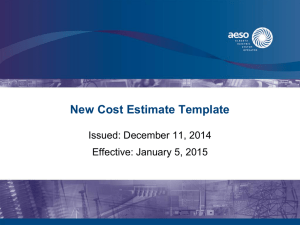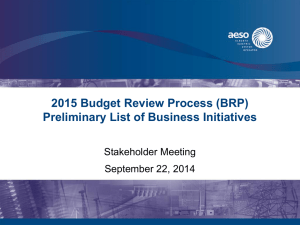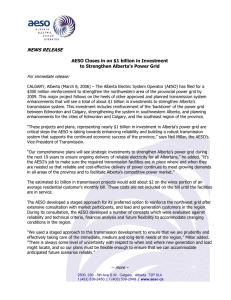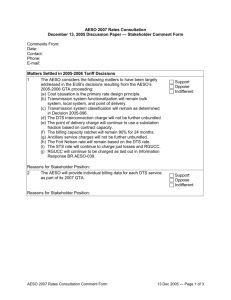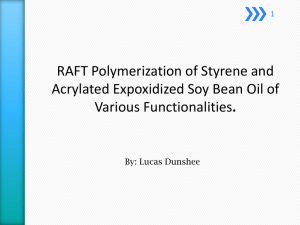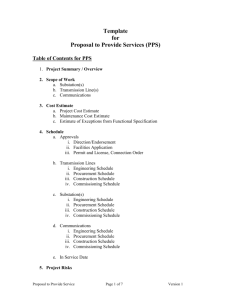ALBERTA ELECTRIC SYSTEM OPERATOR AESO 2005 General Tariff Application (1363012)
advertisement
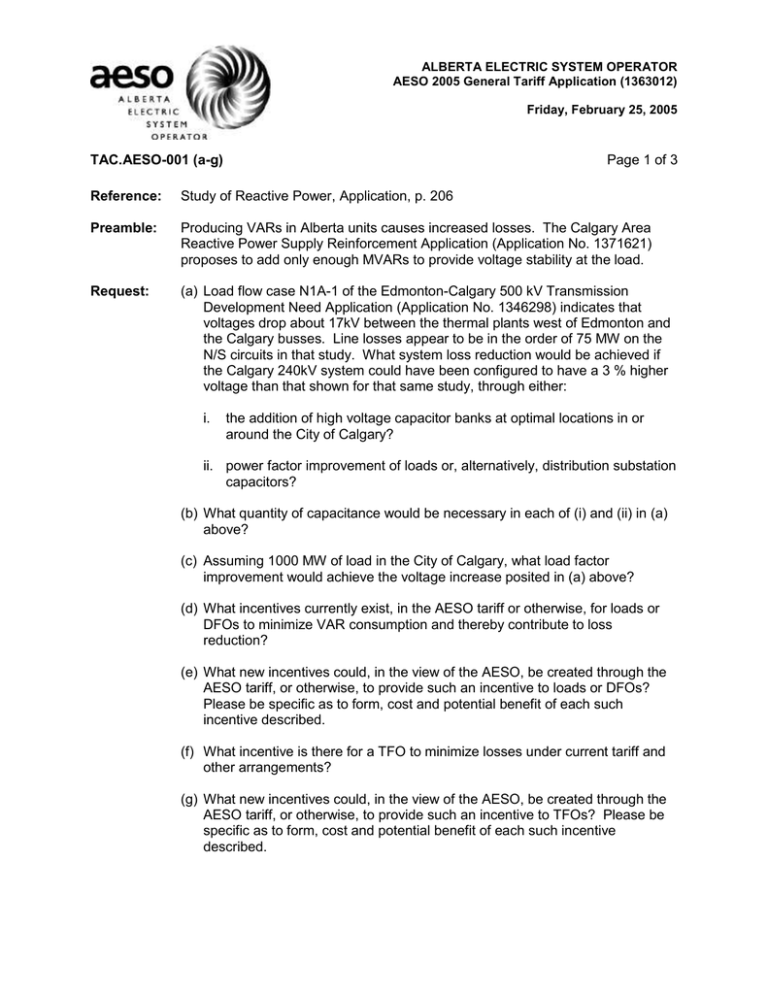
ALBERTA ELECTRIC SYSTEM OPERATOR AESO 2005 General Tariff Application (1363012) Friday, February 25, 2005 TAC.AESO-001 (a-g) Page 1 of 3 Reference: Study of Reactive Power, Application, p. 206 Preamble: Producing VARs in Alberta units causes increased losses. The Calgary Area Reactive Power Supply Reinforcement Application (Application No. 1371621) proposes to add only enough MVARs to provide voltage stability at the load. Request: (a) Load flow case N1A-1 of the Edmonton-Calgary 500 kV Transmission Development Need Application (Application No. 1346298) indicates that voltages drop about 17kV between the thermal plants west of Edmonton and the Calgary busses. Line losses appear to be in the order of 75 MW on the N/S circuits in that study. What system loss reduction would be achieved if the Calgary 240kV system could have been configured to have a 3 % higher voltage than that shown for that same study, through either: i. the addition of high voltage capacitor banks at optimal locations in or around the City of Calgary? ii. power factor improvement of loads or, alternatively, distribution substation capacitors? (b) What quantity of capacitance would be necessary in each of (i) and (ii) in (a) above? (c) Assuming 1000 MW of load in the City of Calgary, what load factor improvement would achieve the voltage increase posited in (a) above? (d) What incentives currently exist, in the AESO tariff or otherwise, for loads or DFOs to minimize VAR consumption and thereby contribute to loss reduction? (e) What new incentives could, in the view of the AESO, be created through the AESO tariff, or otherwise, to provide such an incentive to loads or DFOs? Please be specific as to form, cost and potential benefit of each such incentive described. (f) What incentive is there for a TFO to minimize losses under current tariff and other arrangements? (g) What new incentives could, in the view of the AESO, be created through the AESO tariff, or otherwise, to provide such an incentive to TFOs? Please be specific as to form, cost and potential benefit of each such incentive described. Page 2 of 3 Response: (a) i. To achieve a 3% higher pre-contingency voltage for Case N1A-1, about 450 MVAr of capacitors is required in the Calgary area – assuming that they are connected to the Sarcee and Janet 240 kV buses. The total system losses for this case would be reduced by about 13 MW as compared to the N1A-1 case. ii. To achieve the same voltage improvement as described above, the power factor for loads in the City of Calgary must be improved from 0.925 to 0 .995. The total system losses for this case would be reduced about 15 MW as compared to the N1A-1 case. (b) In (i), about 450 MVAr of capacitance would be necessary. In (ii), about 440 MVAr of capacitance would be necessary. (c) Assuming the system load in the City of Calgary load is at the 1000 MW level, the voltage increase posited in (a) above would be achieved without load factor improvement due to the fact that the power demand in the Calgary area in Case N1A-1 was 1378 MW. (d) The Other System Support Services Charge of both the current and proposed DTS rates includes a power factor deficiency charge of $400/MVA applied to the difference between the highest metered apparent power (measured in MVA) and 111% of the highest metered demand (measured in MW) during the same billing period. A customer minimizes the difference between apparent power and metered demand by minimizing VAR consumption. (e) There are many possible ways to increase prices to customers for VAR consumption, which would presumably be considered as incentives to lower such consumption. Possibilities include charges for demand measured in MVA instead of MW, direct charges for VARs consumed, and power factor deficiency charges for any difference between apparent power and metered demand. Other less direct incentives could include subsidization of the installation of capacitance and high power factor equipment by customers. The current power factor deficiency charge in the DTS rate reflects traditional tariffs in Alberta which have not penalized power factors above 90%, and the AESO has not conducted any specific analysis of additional incentives. (f) There are presently no explicit incentives for TFOs to minimize transmission system losses under the current TFO tariffs. The AESO notes that the relationship between the AESO and the TFO is defined in the TFOs’ tariffs, also approved by the AEUB, and not the AESO’s tariffs applicable to system access service customers. Transmission losses are impacted by the configuration of the transmission system, operating voltages and other related parameters, and by load and generation patterns on the system at each moment in time. As the AESO is responsible for the planning of capital additions to the transmission system as well as overseeing the day to day voltage dispatch of the transmission system, the AESO sees limited opportunity for TFOs to materially affect transmission system losses and thus warrant the development of a specific incentive plan focused on this result. The AESO considers transmission losses savings as a key component in planning transmission system reinforcements and additions, and has also 2 Page 3 of 3 been supplementing the capability of the System Coordination Centre to improve the ability to optimize voltage profiles and thus manage transmission system losses more effectively. (g) Please refer to part (f) above. 3 ALBERTA ELECTRIC SYSTEM OPERATOR AESO 2005 General Tariff Application (1363012) Friday, February 25, 2005 TAC.AESO-002 (a-h) Reference: Page 1 of 4 Application, p. 194: “… the AESO is in the process of studying the interconnection transfer limits based on the system additions and changes that have occurred over the past few years. Completion of that study is a pre-requisite to studying the system for possible generator out-of-merit dispatch volumes that may create additional export ATC. As stated earlier, it is only the Calgary area generators that are likely to be able to create additional export ATC through out-of-merit dispatch. The AESO considers that for the suggested service to be effective at facilitating export of in-merit generation, the amount of out-of-merit generation required to increase export capabilities must be far less than the amount of incremental export capability created. While these scenarios have not been studied, the past trends observed by the AESO in preparation of operational studies have led the AESO to conclude that unfortunately, the ratio is approximately 1:1, or, expressed differently, an incremental MW of Calgary generation dispatched outof-merit only increases the export capability by approximately 1 MW. In effect, the Calgary area generation is only creating enough export capability for that energy in turn to be exported. Given these issues, the AESO concludes that an open offer to dispatch out-ofmerit generationto create additional export capability is not reasonable at this time. However, the AESO has been contacted by Calgary area generation interested in exporting that generation, when it is out-of-merit, over the incremental export capacity the generation could create. The AESO will explore this issue on a case-by-case basis, but is not proposing to change the existing opportunity rates in this application.” Preamble: At times the price differential between Alberta and the BC / PACNW markets is substantial, but sufficient export capability does not always exist. The AESO has an obligation to restore export capabilities to path rating levels. North / South transmission constraints are a part of the current problem. Until there is enough additional MVAR support in the Calgary area that steady state voltage stability ceases to be a binding export capacity constraint, each MVAR added in the Calgary area increases the N/S transfer capability by 1 MW. TMR is, according to the above passage from the Application, not the solution. Meanwhile, TMR needs are increasing pending upgrade of the N/S path. TransAlta wishes to explore the extent to which TMR costs could be reduced, while export / import capability restored, through other means. Request: (a) What order of magnitude of TMR cost reduction could be achieved as a result of the increased N/S transfer capability posited in TAU.AESO-001 (a)(i) and (ii), respectively, by the high voltage capacitor bank additions and power factor improvements of loads / distribution station capacitors there considered? Page 2 of 4 (b) What effect on increased export capacity through the B.C. Tie would the AESO anticipate to occur through the increased N/S transfer capability posited in TAU.AESO-001 (a)(i) and (ii), respectively, by the high voltage capacitor bank additions and power factor improvements of loads / distribution station capacitors there considered? (c) The addition of the N/S facilities currently proposed by means of the 500 KV Transmission System Reinforcement Edmonton – Calgary Area Need Application (Application No. 1346298) will, when installed, only partially restore the capability to use the B.C. Tie export path ratings. What studies has the AESO performed with respect to the ability of increased N/S transfer capability posited in TAU.AESO-001 (a)(i) and (ii), respectively, by the high voltage capacitor bank additions and power factor improvements of loads / distribution station capacitors there considered, to be part of the means to achieve full restoration of the capability to use the B.C. Tie export path ratings? (d) What incentives currently exist, in the AESO tariff or otherwise, for loads or DFOs to minimize TMR requirements on the system? (e) To the extent that the current incentives as per (d) arise solely from the level of ancillary services costs in DTS charges, what examination has the AESO performed as to costs of further high voltage capacitor banks and/or power factor improvements of loads / distribution system capacitors versus ancillary services costs savings? (f) What new incentives could, in the view of the AESO, be created through the AESO tariff, or otherwise, to provide incentive to loads or DFOs to reduce TMR need on the system? Please be specific as to form, cost and potential benefit of each such incentive described. (g) What incentive is there for a TFO to minimize TMR needs under current tariff and other arrangements? (h) What new incentives could, in the view of the AESO, be created through the AESO tariff, or otherwise, to provide such an incentive to TFOs? Please be specific as to form, cost and potential benefit of each such incentive described. Response: (a) The requirement for TMR in the Calgary area is based on pre and post contingency reactive requirements to maintain a sufficient voltage stability margin. The level of reactive reinforcements posited in TAU.AESO-001 (a)(i) and (ii) are similar to the 520 MVAr proposed by AESO for 2005. With this level of reactive support, TMR requirements to maintain voltage stability in the Calgary area should be reduced to zero to at least the summer of 2007. (b) With the high voltage capacitor bank additions or the power factor improvements posited in TAU.AESO-001 (a)(i) and (ii) respectively, the B.C. Tie export capacity at the peak demand periods can be increased up to 700 MW. This is the maximum level permitted on the BC Tie to prevent over frequency in Alberta following the loss of that tie. However, it should be noted 2 Page 3 of 4 that the thermal capability of the north-south lines may limit the ATC of the BC Tie to a lower level. (c) All of the studies performed for Application No. 1346298 included the addition of sufficient reactive resources to satisfy the voltage stability margins of the planning criteria. As such, high voltage capacitor bank additions are considered in all studies to be "part of the means" to achieve full restoration of the capability to use the B.C. Tie export path rating. No studies have yet been completed to determine the impact of the capacitor bank additions in Calgary to the existing OPP which set the limits for exports to B.C. As stated in Application No. 1346298, north-south transfer capability is constrained by the thermal limits on the existing lines once the voltage stability constraint has been removed. Furthermore, unless some form of generation rejection scheme is implemented the 700 MW limit related to over frequency concerns will still apply. (d) The current AESO tariff recovers TMR costs as a percentage of pool price, which the Ancillary Services Cost of Service Study (included as Appendix C to the AESO’s 2006 GTA) concluded was an inappropriate approach. The AESO’s proposed tariff recovers TMR costs as a flat usage ($/MWh) charge, which is more reflective of the manner in which TMR costs are incurred as discussed on page 13 of section 4 of the Application. With recovery of TMR costs as a flat usage charge, customers are encouraged to minimize TMR requirements on the system at all times. (e) As discussed in part (c) above, studies performed by the AESO include the addition of reactive resources. The costs of such resources, when implemented, would be appropriately included in and recovered through the AESO tariff. (f) As explained in the Ancillary Services Cost of Service Study, TMR costs are tied to a combination of hourly gas prices, pool prices, heat rate, and output. Providing a direct incentive to customers to reduce TMR need on the system would be complex. The AESO has instead proposed recovery of TMR costs through a flat usage charge, which generally aligns with cost incurrence and provides a clear price signal to customers. The AESO has not conducted any specific analysis of additional incentives that may be possible but at the same time impractical. (g) Similar to the AESO’s response to TAU.AESO-001 (f) regarding transmission losses, there are presently no explicit incentives for TFOs to minimize TMR costs under the current TFO tariffs. The AESO notes that the relationship between the AESO and the TFO is defined in the TFOs’ tariffs, also approved by the AEUB, and not the AESO’s tariffs applicable to system access service customers. TMR costs are impacted by the configuration of the transmission system and by load and generation patterns on the system at each moment in time. As the AESO is responsible for the planning of capital additions to the transmission system as well as overseeing the day to day operation of the 3 Page 4 of 4 transmission system, the AESO sees limited opportunity for TFOs to materially affect TMR costs and thus warrant the development of a specific incentive plan focused on this result. The AESO considers the viability of TMR arrangements and associated costs in planning and operating decisions on a case-by-case basis and also, on a going forward basis, the conditions placed on use of TMR through the Transmission Development Policy and the Transmission Regulation. (h) Please refer to (g) above. 4 ALBERTA ELECTRIC SYSTEM OPERATOR AESO 2005-06 General Tariff Application (1363012) February 25, 2005 TAC.AESO-003 (a-d) Page 1 of 1 Reference: Application Section 9, page 24, AESO 2003 Negotiated Settlement Agreement, Item 3, Paragraph 23. Preamble: Among the items on Appendix 4 of the 2003 Negotiated Settlement was consideration of the merits of the establishment of a reactive power market. The current 2006 GTA Application indicates that ongoing consultations are continuing with respect to items in the 2003 Negotiated Settlement. Request: (a) Please discuss the state of the ongoing consultations as they bear on the establishment of a reactive power market, including the parties included in such consultations, the date and outcome of the last consultative meeting, and the anticipated date and agenda for the next such meeting. (b) Please discuss the plan or intent of the AESO with respect to the establishment of a reactive power market. (c) Please summarize the benefits to the Alberta market that the AESO would see in the establishment of a reactive power market. (d) Please discuss any detriments to the Alberta market that the AESO would see in the establishment of a reactive power market. Response: (a) Based upon the research documented in the March 18, 2003 report entitled “Reactive Power as an Identifiable Ancillary Service” published on the AESO’s website, the AESO has not been engaging in additional dialogue on this topic. The AESO considers its present treatment of reactive power within the more traditional generator output ranges to be reasonable and consistent with other jurisdictions, and is not intending to pursue other potential arrangements at this time. As area-specific requirements may occur in the future and recognizing that reactive power is extremely localized and therefore would create a somewhat illiquid market, the AESO would expect to pursue solutions other than a development of a market in those regards. The AESO is open to additional stakeholder input to continue pursuing such possibilities if broad stakeholder support exists. (b) Please refer to (a) above. (c) Please refer to (a) above. (d) Please refer to (a) above. ALBERTA ELECTRIC SYSTEM OPERATOR AESO 2005-06 General Tariff Application (1363012) February 25, 2005 TAC.AESO-004 (a-e) Page 1 of 2 Reference: Appendix C, Ancillary Services Cost of Service Study. Preamble: Page 17 and 18 of the EnVision Cost of Service Study and the recent RFP for reactive support in the Calgary region demonstrate voltage control causes substantial and increasing Ancillary Services costs. The AESO states at page 13 of Section 4 that generators are not paid for reactive power dispatches. Request: (a) Please confirm that the terms of interconnection agreements and the pool rules currently obligate generators to accept MVAR output dispatches up to the maximums determined by the ratio of MVAR vs. MW output (a term known as power factor). (b) Please advise whether the matters in (a) are the factors that lead to nonpayment to generators for reactive power dispatches. If other matters pertain, please describe such matters, and the rationale behind them as to why generators are not paid for reactive power dispatches. (c) Please confirm that generator MVAR capability is actually higher at low loads when the maximum determined by the power factor requirement is lower. (d) Would the AESO agree that generators could have additional reactive power resources available at times when the market has not accepted their energy offer? (e) Would the AESO agree that it would be appropriate to enable generators to respond to RFPs for reactive power or to enter into bilateral agreements for reactive power with loads in their region? Response: (a) Confirmed. (Note that power factor = MW / MVA). As discussed in the research paper on this topic referred to in TAC-AESO-03, it is common practice for control areas to specify power factor ranges within which interconnected generators must be able to operate. (b) There is no payment for reactive power under the interconnection requirements primarily because operating a generator within the specified power factor range is considered generally a reasonable interconnection obligation requirement, the provision of this level of reactive power (either as dispatched or in response to a sudden change in system conditions) has a minimal impact on generator real power production, and reactive power requirements are generally extremely localized so compensation through a market approach is not necessarily practical. (c) At lower load levels, most generators have some additional reactive power capability beyond the power factor range specified by the AESO, as the thermal limitations on the generators are eased. Other limitations continue to Page 2 of 2 impact the total available reactive power supply, including limitations in the field exciter. (d) Under certain conditions this may be possible. (e) Depending on the nature of the RFP and the requirements of the AESO, it may be reasonable for generators to offer reactive power capability beyond that required by the AESO’s terms and conditions of service into RFP’s for reactive power supply. The technical considerations will have to be taken into account on a case by case basis. It may also be practical for generators or loads that are having difficulty meeting their individual reactive power requirements to contract directly with a generator within appropriate electrical proximity for additional reactive support. These arrangements, as well, would need to be considered on a case by case basis. 2 ALBERTA ELECTRIC SYSTEM OPERATOR AESO 2005-06 General Tariff Application (1363012) February 25, 2005 TAC.AESO-005 (a-c) Page 1 of 1 Reference: Section 6.1 Customer Contribution Policy, page 13 re discount rate assumptions. Request: (a) Please confirm that the reference on line 10 of page 13 of section 6 of the Application to “Article 9.9” of the proposed T&Cs should be a reference to Article 9.12. If not, please explain the reference as made. (b) The calculation as set out in Article 9.12 of the proposed T&C’s in section 7 of the Application appears to apply the (1 - tax rate) tax adjustment to both the debt and the equity portions of the assumed financing. Please confirm that the formula as provided is incorrect, and provide the corrected formula. (c) The example set out on page 13 of Section 6 of the Application, when properly calculated, appears to arrive at an after-tax discount rate of 9.22% rather than 9.27%. Please confirm, or if confirmation can not be made, provide the calculation of the after-tax discount rate based on the example parameters. Response: (a) Confirmed. The reference on page 13 of section 6 should be to Article 9.12. (b) Confirmed. Please refer to Information Response ALPAC.AESO-002 (a). (c) Confirmed. Please refer to Information Response ALPAC.AESO-002 (b). ALBERTA ELECTRIC SYSTEM OPERATOR AESO 2005-06 General Tariff Application (1363012) February 25, 2005 TAC.AESO-006 (a-f) Page 1 of 2 Reference: Section 4, page 40, calculation of Primary Service Credit. Request: In regard to Table 4.9.3: (a) Please provide the detailed calculation showing the capital recovery factor with a result of 11.94% given the following assumptions shown in the note. % Debt: % Equity: Debt Rate: ROE: Tax Rate: Life: 65% 35% 6.30% 9.5% 33.87% 32 years (b) Please verify the annual costs shown in the Table. For example, a capital cost of $750,000 * 11.94% = $89,550 rather than the $89,238 shown for Transformer 1. (c) If the CRF is incorrect then please provide revised calculations supporting the $700 per MW per Month for the PSC. (d) The average monthly credit as calculated in the table is $661 per MW per month. The AESO then uses $700 per MW per month. Please explain how the AESO gets from $661 to $700 per MW per month. In other areas such as the DTS, calculations are detailed to the penny, for example, in the charge of $1677.06 per MW per month (see page 2 of section 7 of the Application). (e) In the definition of "System Contribution" please clarify whether this should refer to Article 9.8 or 9.9. (see page 43 of Section 7 of the Application). (f) In T&C Articles 14.4 (a) and (b), please confirm that the intent is not the “mean metered power” but the “mean maximum metered power”. (see page 69 of Section 7 of the Application). Response: (a) Please refer to Information Response COSC.AESO-004 (b). (b) Please refer to Information Response COSC.AESO-004 (a). (c) Please refer to Information Response COSC.AESO-004 (a). (d) The average monthly amount was simply rounded to $700/MW. The Primary Service Credit amount is an average amount in respect of representative transformer configurations. Additional precision is not appropriate given the average nature of the calculation. The DTS rate, on the other hand, is Page 2 of 2 determined from thorough and approved forecasts of costs and billing determinants, and the additional precision is warranted. (e) The reference in the definition should be to Article 9.9. (f) Confirmed. 2 ALBERTA ELECTRIC SYSTEM OPERATOR AESO 2005-06 General Tariff Application (1363012) February 25, 2005 TAC.AESO-007 (a-d) Page 1 of 1 Reference: Section 4, Rate Design. Preamble: At page 6, the AESO notes 8 cases were used as the basis for the conclusions and that the average of percentage of POD peak load of all PODs at the time of maximum transmission system stress was 73.5 %. The rate design proposes as a result to allocate 73.5% of the 33.4% of costs caused by demand as demand charges and the remainder as usage charges. Page 9 of the same section notes that 500 MW of capacity and 6% of customers have load factors of less than 20% and that the AESO recommendation would result in those customers total bills increasing by between 3% and 20%. That page goes on to propose addressing the specific needs of these customers in a future proceeding reasoning that the stakeholder consultation done to date is inadequate to make a proposal. Request: (a) What percentage of their total POD peak load were the 6% of customers with less than 20% load factor taking in the eight cases upon which rate changes proposed are based? (b) What percentage of the 6% of customers with less than 20% load factor would the AESO estimate take power from the grid only for standby purposes? (c) What number or percentage of low load factors customers were consulted on the issues discussed on page 9? (d) Please summarize the proposals made and concerns raised by low load factor customers in the consultations. Response: (a) Please refer to attached Schedule TAC-AESO-007 A. (b) Please refer to IOR.AESO-10 (a). (c-d) Please refer to ADC.ASEO.17 (a-h). ALBERTA ELECTRIC SYSTEM OPERATOR AESO 2005-06 General Tariff Application (1363012) Friday, February 25, 2005 TAC.AESO-008 (a-c) Page 1 of 1 Titles: Reference: Application, Section 2.3.4, Other Ancillary Services Preamble: The AESO procures certain remedial action schemes (RAS) and includes in tariffs the RAS costs. One such scheme is the Interruptible Load Remedial Action Scheme (ILRAS), designed to support the import capability of the AlbertaBC interconnection, as described on p. 25 of section 2 of the Application. Request: a) Would the AESO concur that it has similar, if not identical, obligations to support the export capability of the Alberta B.C. interconnection? If not, why not? b) The Keephills PPA provides for a “Keephills Tie Line RAS”, defined in Schedule G – System Support Services to mean “the Remedial Action Scheme in respect of Keephills Units 1 and 2 allowing for a unit trip following a tie line trip or combination of tie line trips for tie lines identified as 5L91, 5L98, 5L92 or 1201L.” Please provide the AESO’s knowledge as to how many times in each of 2004, 2003, 2002 and 2001 that the Keephills Tie Line RAS has been armed? c) Would the AESO consider procuring the Keephills Tie Line RAS or similar arrangements with other generating units to support the export capability of the BC Tie in an analogous manner to the support provided by the ILRAS for imports. If not, why not? Response: a) The Transmission Regulation supports increasing intertie capabilities. However the impact of exports on system reliability as compared to the impact of imports is significantly different. This implies the cost to support export capability is different than the cost to support import capability. Therefore the obligations may not be identical. b) To the best of AESO’s knowledge, the Keephills tie line has not been armed in any of 2004, 2003, 2002 and 2001. c) Yes the AESO would consider procuring a tie line RAS that would support export. The AESO is currently completing feasibility study into RAS concepts for extending export capabilities using a generator RAS.

